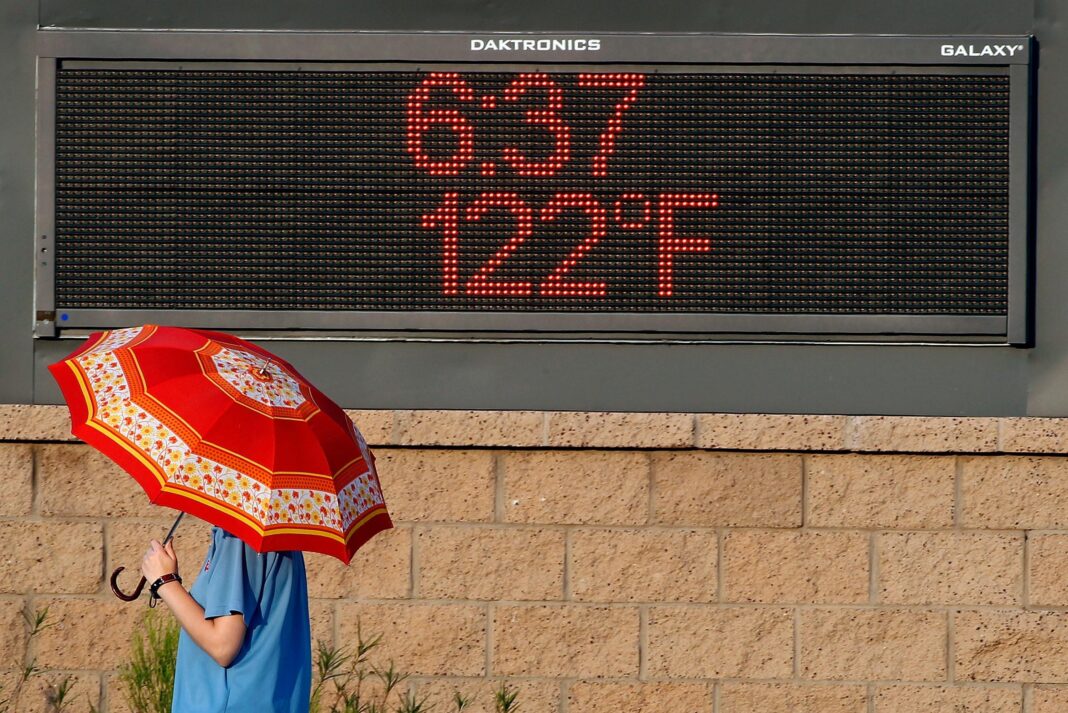Science The Dust Bowl ‘Then’ – Climate Change ‘Now’ Argument Deconstructed Marshall Shepherd Senior Contributor Opinions expressed by Forbes Contributors are their own. New! Follow this author to improve your content experience. Got it! Jun 20, 2022, 08:39pm EDT | Share to Facebook Share to Twitter Share to Linkedin There is no doubt about it.
Much of the United States is going to experience sweltering heat in the coming days as we transition to the summer season. NOAA’s Weather Prediction Center discussion said, “Expect daily record max or min temperatures (to) be set within this area (Great Plains to South), including highs exceeding 100F and lows well into the 70s meaning little relief overnight in many areas. ” Here in Georgia, I see potential air temperature values in the 100 to 107 deg F range.
Unfortunately, there is the typical confusion and posturing about whether such heat is reflective of climate change since there were such temperatures in the 1930s and so on. Throughout my career, I have seen the “Dust Bowl” narrative explicitly and subtly employed to refute contemporary findings related to climate change. I offer some perspective that will hopefully clarify things.
PHOENIX, AZ – JUNE 20: A pedestrian uses an umbrella to get some relief from the sun as she walks . . .
[+] past a sign displaying the temperature on June 20, 2017 in Phoenix, Arizona. Record temperatures of 118 to 120 degrees were expected on Tuesday for the Phoenix-metro area. (Photo by Ralph Freso/Getty Images) Getty Images Yes, the Dust Bowl was brutal.
A National Weather Service website points out that, “The “Dust Bowl” years of 1930-36 brought some of the hottest summers on record to the United States, especially across the Plains, Upper Midwest and Great Lake States. ” Many heat records to this day can be traced back to this period, particularly the Heatwave of 1936. The 1930s were characterized by sustained periods of drought, strong high pressure systems, and soil-vegetation conditions that amplified the hot-dry condition, according to the National Weather Service.
Many all-time record highs here in the South can traced back to the 1930s as well. So yes, the 1930s were hot. To go along with that point, yes, the climate has natural variability .
It always baffles me when this is presented to a climate scientist. Grass grows naturally too, but when the soil is fertilized it grows differently. I say this to make the point that nothing about the record heat of the 1930s refutes the fact that anthropogenic climate change is also happening.
Scientific studies (and data) overwhelmingly point to a warming climate system in recent decades (graphic below), and the Intergovernmental Panel on Climate Change (IPCC) report affirms this with strong certainty. If someone is still debating that, smile and walk away. In recent years, a library of studies by scholars and even the National Academy of Sciences confirms that heatwaves are becoming more intense and frequent due to climate change.
The 2016 attribution study from the National Academy placed the highest level of certainty on the linkage between climate change and heatwave. A recent study found that the intensity of the 2021 Pacific Northwest heatwave was 150 times more likely due to climate change. South of Lamar, Colorado, a large dust cloud appears behind a truck traveling on highway 59, May .
. . [+] 1936.
(Photo by PhotoQuest/Getty Images) Getty Images The best way to place current warming and past heat records in context is to think about a young basketball player with outstanding jumping ability. The 1930s can symbolize his natural ability to jump. As time goes on, climate change added a few layers of wood to the basketball court such that the player, even with his natural ability, has an easier time dunking the basketball.
Even as that happens, it takes nothing away from the fact that the kid always had amazing “bunnies” as the kids say today. MORE FOR YOU New Research Finds A Connection Between Domestic Violence And These Two Personality Disorders This Scientist Helps Andean Forests And Ecuador’s Women In STEM Exceptional Fossil Preservation Suggests That Discovering Dinosaur DNA May Not Be Impossible I do agree that there are some very hyperbolic things likely to be written or said this week as triple-digit heat and life-threatening heat indices engulf much of the country. However, I also do not want overcompensation for that hyperbole to ignore or wash away the reality that climate change is amplifying this generation of heat (and that to come).
It is worth a reminder that seven of the nation’s warmest summers on record have been since 2000, and something tells me it will be eight in a few months. Global average surface temperature differences compared to the last century. NOAA Follow me on Twitter .
Check out my website . Marshall Shepherd Editorial Standards Print Reprints & Permissions.
From: forbes
URL: https://www.forbes.com/sites/marshallshepherd/2022/06/20/the-dust-bowl-thenclimate-change-now-argument-deconstructed/



